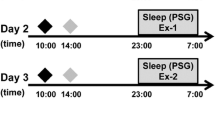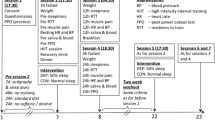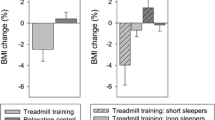Summary
The purpose of this investigation was to examine the influence of daytime exercise on heart rate during sleep. Nine, untrained male college students volunteered to participate. They cycled at 75% maximum oxygen uptake, (\(\dot V\)O2max) 30 min·day−1 for 12 weeks. The exercise duration was increased by 5 min every 4 weeks from 30 to 40 min per session. Post-training \(\dot V\)O2max[mean (SE): 48.9 (1.7) ml · kg−1 · min−1] values were significantly (P<0.01) higher than pre-training [45.5 (1.8) ml-kg−1·min−1] values. Before and after training, sleeping heart rate was assessed on two separate nights. Data were obtained during a night following 30 min of daytime cycling at 75 (6) % \(\dot V\)O2maxand on a night in which no daytime exercise was performed. A three-way repeated measures ANOVA [training status (pre-/post-training) × activity (exercise day/nonexercise day) × sleep time (18 epochs of 20 min each)] revealed a significant main effect for sleep time (P < 0.001) as well as a sleep time × training status interaction (P<0.02). No significant difference in sleeping heart rate was noted when exercise and non-exercise days were compared both before and after training. It is concluded that endurance training in these young adult men: (1) hastens the achievement of baseline heart rate during sleep, and (2) does not moderate the relationship between an acute bout of daytime exercise and sleeping heart rate.
Similar content being viewed by others
References
Bevier WC, Bunnell DE, Horvath SM (1987) Cardiovascular function during sleep of active older adults and the effects of exercise. Exp Gerontol 22:329–337
Blomqvist CG, Saltin G (1983) Cardiovascular adaptations to physical training. Annu Rev Physiol 45:169–189
Bunnell DE, Bevier WC, Horvath SM (1983) Nocturnal sleep, cardiovascular function, and adrenal activity following maximum-capacity exercise. Electroencephalogr Clin Neurophysiol 56:186–189
Bunnell DE, Bevier WC, Horvath SM (1985) Effects of exhaustive submaximal exercise on cardiovascular function during sleep. J Appl Physiol l58:1909–1913
Horne JA (1981) The effects of exercise on sleep: A critical review. Biol Psychiatry 12:241–290
Roussel B, Buguet A (1982) Changes in human heart rate during sleep following daily physical exercise. Eur J Appl Physiol 49:409–416
Sadamoto T, Fuchi T, Taniguchi Y, Miyashita M (1986) Effect of 8 weeks submaximal conditioning and deconditioning on heart rate during sleep in middle-ages women. In: McPherson BD (ed) Sport and aging. Human Kinetics, Champaign, pp 233–240
Sedgwick AW, Craig RJ, Crouch R, Dowling B (1974) The effects of physical training on the day and night longterm heartrates of middle-aged men. Eur J Appl Physiol 33:307–314
Snyder F, Hobson JA, Morrison DF, Goldfrank F (1964) Changes in respiration, heart rate, and systolic blood pressure in human sleep. J Appl Physiol 19:417–422
Walker JM, Floyd TC, Fein G, Cavness C, Lualhati R, Feinberg I (1978) Effects of exercise on sleep. J Appl Physiol 44:945–951
Wehr TA (1992) A brain-warming funcion of REM sleep. Neurosci Biobehav Rev 16:379–397
Author information
Authors and Affiliations
Rights and permissions
About this article
Cite this article
O'Connor, P.J., Crowley, M.A., Gardner, A.W. et al. Influence of training on sleeping heart rate following daytime exercise. Europ. J. Appl. Physiol. 67, 39–42 (1993). https://doi.org/10.1007/BF00377702
Accepted:
Issue Date:
DOI: https://doi.org/10.1007/BF00377702




